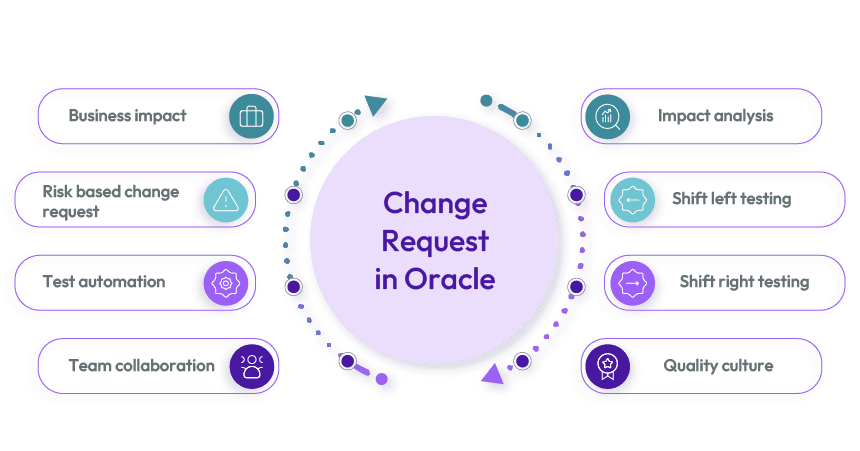Oracle Fusion applications are the backbone of your business, supporting critical operations and driving organizational agility and competitiveness. Given their strategic importance, it’s essential that these applications perform flawlessly — and that’s where testing plays a critical role. However, testing Oracle applications is complex, especially with frequent updates and continuous change requests adding to the challenge. In this blog, we explore best practices for managing Oracle change requests and how Opkey’s ERP Lifecycle Optimization platform can help maintain continuous quality and business continuity.
E-book: Oracle ERP Change Requests: A QA Best Practices Playbook
What are Change Requests?
As your business scales, enters new markets, or adapts to regulatory requirements, your Oracle ERP system must evolve accordingly. This evolution often comes in the form of change requests — formal proposals to modify specific elements such as workflows, purchasing documents, product configurations, or asset records. While necessary, these changes can significantly impact your Oracle environment.
Here’s how change requests can affect your Oracle ERP applications:
- Trigger cascading changes: A single modification can initiate updates across interconnected modules, leading to unplanned disruptions if software testing is not performed properly.
- Impact existing configurations: Changes may overwrite or conflict with previously configured business rules or setups.
- Affect compliance and audit readiness: Untracked or poorly managed changes can lead to non-compliance or audit issues.
- Require regression testing: Each change must be validated to ensure it doesn’t break existing functionality or introduce defects.
- Delay project timelines: Without a structured change management process, approvals, validations, and testing may take longer than expected.
- Disrupt business continuity: If change-related issues go undetected, they can affect key business operations like procurement, finance, or reporting.
- Increase testing workload: Each request adds to the testing backlog, especially when done manually, leading to higher resource utilization.
Impact of Oracle Quarterly Updates
To support their customers, vendors roll out updates throughout the software development lifecycle, and Oracle is no exception to this.
Oracle Fusion applications receive quarterly updates that introduce new features and enhancements to improve performance and functionality. These updates are essential for maintaining efficiency and staying competitive. However, they also pose a challenge: testing teams must ensure that new updates don’t introduce bugs or disrupt existing business processes.
A new patch might override your configurations, or a minor UI change could disrupt your automated scripts. Tracking these changes and ensuring stability is no small feat.
Relying on manual testing for these updates is not only time-consuming and error-prone but also fails to provide sufficient test coverage. It requires significant coordination among testers, developers, business users, and stakeholders, making it inefficient and unsustainable in the long run.

Best practices to Manage Change Requests in Oracle Cloud Applications
When it comes to testing change requests in Oracle Cloud ERP, success depends on applying the right testing principles consistently across every release cycle.
Prioritize Change Requests by Risk and Business Impact
Not every change in your Oracle environment carries the same level of urgency or risk. Begin by categorizing requests based on Oracle’s predefined change types—such as Engineering Change Orders, Commercialization Changes, or Process Updates. Once classified, evaluate the potential business impact using a risk-based approach.
For instance, changes involving financial reporting, payroll, compliance, or security should be prioritized for thorough testing, as they directly affect business continuity and regulatory obligations. On the other hand, minor changes like UI adjustments or non-critical workflow updates can be tested with a lighter approach. This strategic prioritization ensures your testing efforts are aligned with business risk, optimizing resource allocation while reducing the chance of costly disruptions.
Embrace Shift-Left and Shift-Right Testing Approaches
QA testing should be integrated throughout the ERP lifecycle—not just at the end. By adopting Shift-Left testing practices, you bring QA (Quality Assurance) teams into the early planning and design stages, allowing them to review requirements, identify potential risks, and design more effective test scenarios from the start. This proactive approach helps catch defects early, reducing costly rework later. Shift-Right testing, on the other hand, involves monitoring the system post-deployment—analyzing user behavior, logs, and performance data to gain insights and continuously enhance future updates. This testing process creates a feedback-driven, adaptive QA process.
Build a Continuous Quality Culture
Combining Shift-Left and Shift-Right practices helps build a culture of continuous software quality where testing is not a phase but an ongoing activity just like the software development process. This is especially critical in Oracle Cloud environments, where frequent updates and change requests demand agile responses. Leveraging test automation, real-time analytics, and user feedback loops ensure that every release improves over the last—boosting reliability, user satisfaction, and overall ERP performance.
Effective Test Planning and Impact Analysis
Begin by working closely with business stakeholders, QA teams, and functional leads to define clear testing objectives, success metrics, and critical business scenarios. This ensures that testing efforts stay aligned with real business priorities. Next, perform a detailed impact analysis by reviewing the scope of changes, identifying process dependencies, and learning from historical issues to pinpoint high-risk areas.
Strengthen traceability by connecting business requirements to test cases and any resulting defects, enabling complete transparency across the testing lifecycle. Finally, build a balanced test suite that combines regression, scenario-based, and exploratory testing—optimizing for both coverage and efficiency to ensure confident ERP deployments.
Lead with Intelligent Automation
Manual testing cannot scale with the rapid pace of Oracle’s quarterly updates and continuous change requests. To stay ahead, you need to embrace automated testing. Prioritize automation for regression, smoke, integration tests, and sanity test suites—ensuring consistent, fast, and reliable validation of core business processes. Automation accelerates testing cycles, reduces human error, and boosts test coverage across modules.
Opkey is specifically designed to manage Oracle ERP complexities, offering features like no-code test creation, self-healing scripts, and risk-based testing. This allows your QA teams to shift focus from repetitive tasks to high-value initiatives like exploratory and user experience testing—ultimately driving continuous quality and faster innovation.
Foster Cross-Team Collaboration
Ensure seamless coordination by embedding QA into your DevOps and change management workflows. Align development, testing, and operations teams through well-defined communication protocols, service-level agreements (SLAs), and structured approval processes. Centralize visibility and control using testing tools like Opkey to manage test assets, track changes, maintain audit trails, and store critical documentation — all in one unified space. This integrated approach helps reduce silos, accelerates delivery, and ensures traceability across the ERP lifecycle.
ERP Lifecycle Optimization
Want to learn how Opkey supports Oracle Change Requests? Book a demo
Frequently Asked Questions
Also known as UX (user experience) testing, it is a software testing process where a software application is tested by real or representative users. The main purpose of user testing is to uncover the pain points in the customer journey to highlight opportunities where there is scope of improvement in the overall user experience. Thus, we can say that the goals of usability testing are:
- Identifying problems in the design of an application
- Uncovering opportunities to improve
- Learning about the target user’s behavior and preferences
User acceptance testing is essentially a method that determines whether a new or upgraded solution is usable by the user. Even if it’s completed in the latter stages of software implementation, that doesn’t mean it isn’t important or may be skipped altogether.
Functional testing verifies the features and interfaces of a software product. It is a black box testing type that involves mimicking real-world conditions to test the final product with actual users.
White-box testing includes Unit Testing, Integration Testing, Security Testing, and Regression Testing.
Black box testing encompasses functional, non-functional, performance testing, and regression testing.
Opkey’s Test Data Management solution streamlines test data generation, availability, and automation. It helps maintain accurate and up-to-date test data while facilitating easy change tracking and rollback.
Opkey empowers development and Operations team with seamless test automation, enabling faster releases and enhanced collaboration across the ERP lifecycle. Opkey’s AI-powered test software supports testing phase and shift-left testing practices in order to maximize your ERP ROI. Opkey supports multiple testing methodologies. Whether you want to perform security testing, unit testing, integration testing, or compatibility testing, Opkey supports you at every step of digital transformation.
The most effective approach to modern QA automation testing is to leverage an intelligent, unified, and no-code platform that seamlessly manages the complexities of enterprise applications and minimizes the burden of test maintenance.
Zero-Code Simplicity and Speed: An intuitive, drag-and-drop or record-and-playback interface is recommended as it allows users to create complex end-to-end tests in minutes.
Pre-Built Test Accelerators: To achieve instant coverage, the tool must offer a vast library of pre-built, ready-to-use automated test components for major enterprise applications, eliminating the need to build core regression suites from scratch.
AI-Powered Maintenance: The platform must use AI to automatically detect changes in the application’s UI or underlying code and self-heal the impacted test scripts.
Intelligent Impact Analysis: An advanced engine should instantly track application updates and pinpoint exactly which business processes and test cases are at risk, allowing teams to focus testing efforts only where they are needed.
Seamless CI/CD Integration: Tool must integrate natively and effortlessly into existing DevOps pipelines, enabling continuous testing and ensuring quality gates are enforced with every code commit.
That’s why we recommend Opkey.






